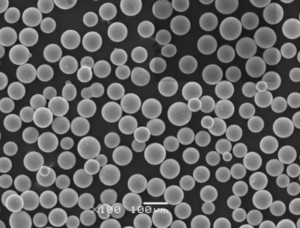Genel Bakış Binder Jet 3D Baskı
Binder Jet 3D Baskı (BJ3DP), karmaşık, yüksek mukavemetli metal parçaları büyük ölçekte üretme kabiliyetiyle öne çıkan son teknoloji bir eklemeli üretim sürecidir. Diğer 3D baskı teknolojilerinin aksine, Binder Jetting malzemenin eritilmesini içermez, bu da daha hızlı üretim sürelerine, daha düşük enerji tüketimine ve özellikle metal tozları olmak üzere çok çeşitli malzemelerle çalışma yeteneğine olanak tanır.
Bu teknoloji özellikle hassasiyet, verimlilik ve malzeme esnekliğinin kritik öneme sahip olduğu sektörlerde avantajlıdır. İster havacılık, ister otomotiv, hatta ister sağlık hizmetleri olsun, Binder Jet 3D Baskı, karmaşık metal bileşenler üretmek için uygun maliyetli, ölçeklenebilir bir çözüm sunarak dalgalar yaratıyor.
Binder Jet 3D Baskının Arkasındaki Bilim
Binder Jetting nispeten basit bir prensiple çalışır. Sıvı bir yapıştırıcı olan bir bağlayıcı, seçici olarak bir toz yatağı üzerine katman katman bırakılır. Bağlayıcının uygulandığı alanlar istenen şekli oluşturmak için sertleşirken, çevredeki toz gevşek kalır ve yeniden kullanılabilir. Nesne tamamen şekillendirildikten sonra, nihai yoğunluğunu ve mukavemetini elde etmek için sinterleme gibi bir işlem sonrası adımdan geçer.
Binder Jet 3D Baskı Nasıl Çalışır?
- Adım 1: Pudranın Katmanlanması: Yapı platformu üzerine ince bir metal tozu tabakası yayılır.
- Adım 2: Bağlama: Bir baskı kafası seçici olarak bağlayıcıyı tozun üzerine bırakarak parçanın şeklini oluşturur.
- Adım 3: Tekrarlama: Süreç, tüm parça inşa edilene kadar katman katman tekrarlanır.
- Adım 4: Kürleme: Parça, bağlayıcının katılaşması için kürlenmeye bırakılır.
- Adım 5: Sinterleme: Son adım, toz parçacıklarını kaynaştırmak ve istenen mekanik özellikleri elde etmek için parçanın bir fırında ısıtılmasını içerir.
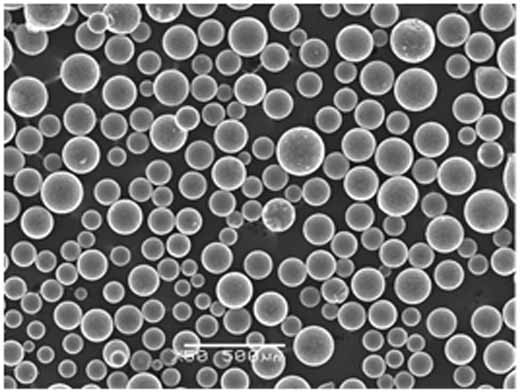
Binder Jet 3D Baskının Temel Özellikleri
| Karakteristik | Açıklama |
|---|---|
| Malzeme Çok Yönlülüğü | Paslanmaz çelik, titanyum ve Inconel dahil olmak üzere çok çeşitli metal tozları ile çalışır. |
| Hız | Malzemenin eritilmesini gerektirmediği için diğer metal 3D baskı yöntemlerinden daha hızlıdır. |
| Maliyet-Etkililik | Daha az enerji tüketimi ve tozun yeniden kullanılabilmesi sayesinde daha düşük işletme maliyetleri. |
| Yüzey İşlemi | Genellikle pürüzsüz yüzeyler elde etmek için sonradan işlem gerektirir. |
| Parça Gücü | Sinterlemeden sonra geleneksel olarak üretilen parçalarla karşılaştırılabilir. |
| Ölçeklenebilirlik | Aynı anda birden fazla parça üretmek için çok uygundur. |
Avantajları Binder Jet 3D Baskı
- Üretimde Verimlilik: SLM (Seçici Lazer Eritme) gibi yöntemlerle karşılaştırıldığında, Binder Jetting daha hızlıdır ve daha az enerji tüketir, bu da onu büyük ölçekli üretim için ideal hale getirir.
- Malzeme Esnekliği: Çelik, alüminyum ve hatta seramik malzemeler de dahil olmak üzere çeşitli metal tozlarını kullanabilmesi, onu farklı endüstriler için çok yönlü hale getirir.
- Uygun Maliyetli: Daha düşük enerji gereksinimleri ve bağlanmamış tozu yeniden kullanma yeteneği ile Binder Jetting genellikle diğer 3D baskı yöntemlerinden daha ekonomiktir.
- Çevresel Etki: Bu yöntem, yüksek enerjili lazerler veya elektron ışınları içermediği için daha az atık üretir ve daha küçük bir karbon ayak izine sahiptir.
Binder Jet 3D Baskıda Kullanılan Spesifik Metal Tozları
Binder Jetting, etkileyici bir metal tozu yelpazesi ile çalışabilir. Aşağıda, bazı spesifik modelleri inceleyeceğiz:
| Metal Tozu Modeli | Açıklama |
|---|---|
| 316L Paslanmaz Çelik | Mükemmel korozyon direnci ve mekanik özellikleriyle bilinir, bu da onu denizcilik ve tıbbi uygulamalar için ideal kılar. |
| 17-4 PH Paslanmaz Çelik | Havacılık ve askeri sektörlerde yaygın olarak kullanılan yüksek mukavemet ve sertlik sunar. |
| Inconel 625 | Genellikle havacılık ve uzay endüstrisinde kullanılan, olağanüstü yüksek sıcaklık direncine sahip nikel bazlı bir süper alaşım. |
| Inconel 718 | Oksidasyona ve korozyona karşı yüksek dirençli, aşırı ortamlar için uygun bir başka nikel bazlı alaşım. |
| Kobalt-Krom | Son derece dayanıklı ve biyouyumlu olması sayesinde diş ve ortopedik implantlar için mükemmeldir. |
| Bakır | Elektronik ve ısı eşanjörlerinde kullanılan mükemmel elektriksel ve termal iletkenlik sunar. |
| Titanyum Ti6Al4V | Havacılık ve tıbbi implantlarda yaygın olarak kullanılan yüksek mukavemet ve korozyon direncine sahip hafif. |
| Alüminyum AlSi10Mg | Hafif ve dayanıklıdır, ağırlık azaltmanın kritik olduğu otomotiv ve havacılık parçaları için idealdir. |
| Bronz | Aşınma direnci ve düşük sürtünmesi ile bilinir, genellikle rulmanlarda ve burçlarda kullanılır. |
| Tungsten | Yüksek yoğunluk ve sıcaklık direnci, havacılık ve uzay gibi yüksek termal stabilite gerektiren uygulamalar için uygundur. |
Binder Jet 3D Baskı Tozlarının Bileşimi
| Metal Tozu | Birincil Bileşenler | Mülkler |
|---|---|---|
| 316L Paslanmaz Çelik | Demir, Krom, Nikel, Molibden | Yüksek korozyon direnci, iyi kaynaklanabilirlik. |
| 17-4 PH Paslanmaz Çelik | Demir, Krom, Nikel, Bakır | Yüksek mukavemet, iyi sertlik, korozyon direnci. |
| Inconel 625 | Nikel, Krom, Molibden, Niyobyum | Mükemmel yüksek sıcaklık dayanımı, korozyon direnci. |
| Inconel 718 | Nikel, Krom, Demir, Niyobyum, Titanyum | Oksidasyon direnci, yüksek sıcaklık kararlılığı. |
| Kobalt-Krom | Kobalt, Krom, Molibden | Biyouyumluluk, aşınma direnci, yüksek mukavemet. |
| Bakır | Bakır | Yüksek elektrik ve ısı iletkenliği. |
| Titanyum Ti6Al4V | Titanyum, Alüminyum, Vanadyum | Hafif, korozyona dayanıklı, biyouyumlu. |
| Alüminyum AlSi10Mg | Alüminyum, Silikon, Magnezyum | Hafif, iyi mekanik özellikler. |
| Bronz | Bakır, Kalay | Düşük sürtünme, aşınma direnci, anti-korozif. |
| Tungsten | Tungsten | Yüksek erime noktası, yüksek yoğunluk, mukavemet. |
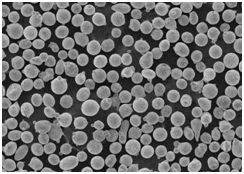
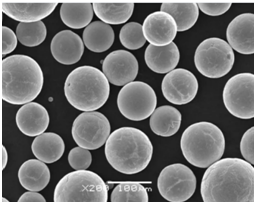
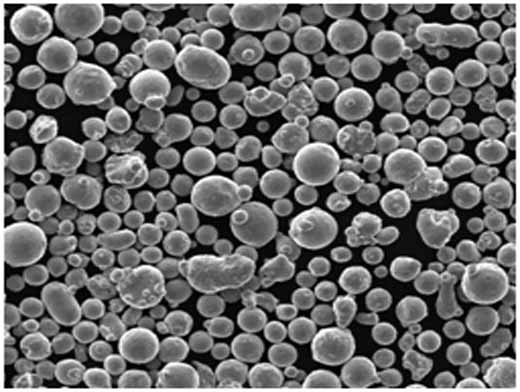
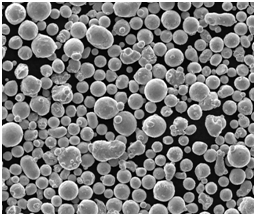

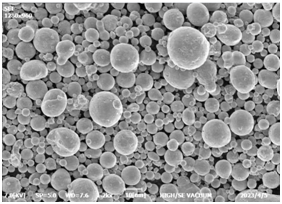
Uygulamaları Binder Jet 3D Baskı
Binder Jetting, her bir metal tozu modelinin farklı amaçlara hizmet ettiği çeşitli endüstrilerde kullanılmaktadır.
| Endüstri | Uygulama | Metal Tozu Modeli |
|---|---|---|
| Havacılık ve Uzay | Motor bileşenleri, türbin kanatları | Inconel 625, Inconel 718 |
| Otomotiv | Hafif parçalar, prototipler | Alüminyum AlSi10Mg, Titanyum Ti6Al4V |
| Tıbbi | Ortopedik implantlar, cerrahi aletler | Titanyum Ti6Al4V, Kobalt-Krom |
| Denizcilik | Korozyona dayanıklı parçalar | 316L Paslanmaz Çelik |
| Elektronik | Isı alıcıları, konektörler | Bakır |
| Askeri | Silah bileşenleri, zırh | 17-4 PH Paslanmaz Çelik |
| Enerji | Türbin kanatları, nükleer bileşenler | Inconel 625, Tungsten |
| Takı | Özel metal takılar | Bronz, Kobalt-Krom |
| Endüstriyel | Rulmanlar, burçlar | Bronz, 316L Paslanmaz Çelik |
| İnşaat | Yapısal parçalar, bağlantı parçaları | 316L Paslanmaz Çelik, Alüminyum AlSi10Mg |
Metal Tozları için Spesifikasyonlar ve Standartlar
Binder Jet 3D Baskıda kullanılan metal tozlarının spesifikasyonlarını, boyutlarını ve standartlarını anlamak, nihai ürünün gerekli kalite ve performans ölçümlerini karşılamasını sağlamak için çok önemlidir.
| Metal Tozu Modeli | Parçacık Boyutu (Mikron) | Yoğunluk (g/cm³) | Sinterleme Sıcaklığı (°C) | Standartlar |
|---|---|---|---|---|
| 316L Paslanmaz Çelik | 15-45 | 7.9 | 1250-1400 | ASTM A276, A240 |
| 17-4 PH Paslanmaz Çelik | 20-53 | 7.7 | 1200-1300 | AMS 5604, ASTM A564 |
| Inconel 625 | 15-45 | 8.4 | 1250-1400 | ASTM B443, B446 |
| Inconel 718 | 15-53 | 8.19 | 1250-1400 | AMS 5596, ASTM B637 |
| Kobalt-Krom | 10-45 | 8.3 | 1150-1350 | ASTM F75 |
| Bakır | 15-45 | 8.96 | 1080-1125 | ASTM B152 |
| Titanyum Ti6Al4V | 20-53 | 4.43 | 1250-1400 | ASTM F1472, AMS 4911 |
| Alüminyum AlSi10Mg | 20-63 | 2.67 | 555-630 | EN 1706, ISO 3522 |
| Bronz | 10-45 | 8.7 | 900-950 | ASTM B505 |
| Tungsten | 5-45 | 19.3 | 1500-1700 | ASTM B777 |
Binder Jet 3D Baskı: Artıları ve Eksileri
Binder Jet 3D Baskının faydalarını ve sınırlamalarını tam olarak anlamak için, artıları ve eksileri tartmak çok önemlidir.
| Avantajlar | Dezavantajlar |
|---|---|
| Hız: Hızlı üretim süreci | İşlem Sonrası: Yoğunlaştırma için ek adımlar gerektirir |
| Malzeme Esnekliği: Çok çeşitli kullanılabilir tozlar | Yüzey İşlemi: Genellikle ikincil işlemeye ihtiyaç duyar |
| Maliyet-Etkililik: Düşük işletme maliyetleri | Güç: Uygun sinterleme olmadan parçalar daha az yoğun olabilir |
| Ölçeklenebilirlik: Seri üretime uygun | Gözeneklilik: Diğer yöntemlere kıyasla daha yüksek gözeneklilik potansiyeli |
| Çevresel Etki: Düşük atık üretimi | Tasarım Kısıtlamaları: Toz akışkanlığı ve katman yapışması ile sınırlıdır |
Metal Tozları için En İyi Tedarikçiler Binder Jet 3D Baskı
Yüksek kaliteli metal tozlarının mevcudiyeti, Binder Jet 3D Baskı'nın başarısı için çok önemlidir. Aşağıda bazı en iyi tedarikçiler ve fiyatlandırma detayları yer almaktadır.
| Tedarikçi | Metal Tozu Modelleri Mevcuttur | Fiyat Aralığı (USD/kg) | Konum |
|---|---|---|---|
| Höganäs AB | 316L Paslanmaz Çelik, 17-4 PH Paslanmaz Çelik | 50-100 | İsveç |
| GKN Katkı Maddesi | Inconel 625, Inconel 718 | 200-400 | ABD |
| Marangoz Katkısı | Titanyum Ti6Al4V, Kobalt-Krom | 250-500 | ABD |
| Sandvik Osprey | Alüminyum AlSi10Mg, Bronz | 60-150 | BIRLEŞIK KRALLIK |
| LPW Teknoloji | Tungsten, Bakır | 100-250 | BIRLEŞIK KRALLIK |
| AP&C | Titanyum Ti6Al4V, Inconel 718 | 300-600 | Kanada |
| Tekna | Alüminyum AlSi10Mg, Bakır | 50-200 | Kanada |
| Arcam AB | Kobalt-Krom, Titanyum Ti6Al4V | 200-450 | İsveç |
| Erasteel | 316L Paslanmaz Çelik, Bronz | 80-180 | Fransa |
| PyroGenesis | Tungsten, Inconel 625 | 150-300 | Kanada |
Binder Jet 3D Baskı ile Diğer 3D Baskı Teknolojilerinin Karşılaştırılması
Üretim ihtiyaçlarınız için Binder Jetting'i düşünürken, onu Seçici Lazer Eritme (SLM) ve Elektron Işını Eritme (EBM) gibi diğer popüler 3D baskı yöntemleriyle karşılaştırmak çok önemlidir.
| Teknoloji | Hız | Malzeme Aralığı | Yüzey İşlemi | Maliyet | Tipik Uygulamalar |
|---|---|---|---|---|---|
| Bağlayıcı Püskürtme | Hızlı | Geniş (metaller, seramikler) | Kaba, sonradan işleme gerektirir | Düşük (enerji tasarrufu nedeniyle) | Seri üretim, prototipleme |
| Seçici Lazer Eritme (SLM) | Orta düzeyde | Metaller | Pürüzsüz, detaylı | Yüksek (enerji kullanımı nedeniyle) | Havacılık ve uzay, tıbbi implantlar |
| Elektron Işınıyla Eritme (EBM) | Yavaş | Sınırlı (çoğunlukla metaller) | Kaba ama yüksek mukavemetli | Yüksek (ekipman maliyeti nedeniyle) | Havacılık ve uzay, özel parçalar |
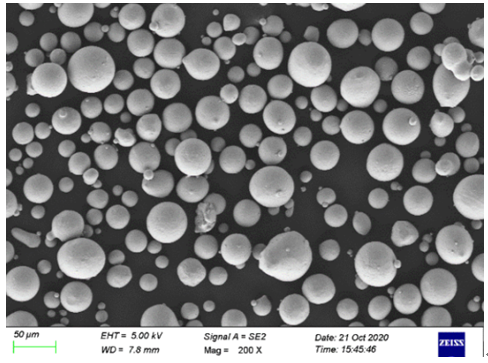
SSS
| Soru | Cevap |
|---|---|
| Binder Jet 3D Baskıda hangi malzemeler kullanılabilir? | Paslanmaz çelik, titanyum ve Inconel dahil olmak üzere çok çeşitli metaller, seramikler ve kompozitler kullanılabilir. |
| Binder Jetting diğer metal 3D baskı yöntemlerinden daha mı hızlı? | Evet, malzemelerin eritilmesini gerektirmediği için genellikle daha hızlıdır ve bu da süreci önemli ölçüde hızlandırır. |
| Binder Jet 3D Baskı güçlü parçalar üretiyor mu? | Evet, uygun sinterlemenin ardından parçalar geleneksel üretim yöntemleriyle üretilenlerle karşılaştırılabilir bir mukavemete ulaşabilir. |
| Binder Jetting kullanan ana sektörler hangileridir? | Havacılık, otomotiv, tıp ve elektronik endüstrileri bu teknolojiyi kullanan kilit sektörlerden bazılarıdır. |
| Binder Jetting'de işlem sonrası her zaman gerekli midir? | Genellikle evet. Sinterleme veya infiltrasyon gibi işlem sonrası süreçler, parçaların mekanik özelliklerini ve finisajını geliştirmek için gereklidir. |
| Binder Jetting maliyet açısından diğer yöntemlerle nasıl karşılaştırılır? | Daha düşük enerji gereksinimi ve tozların yeniden kullanılabilmesi nedeniyle genellikle daha uygun maliyetlidir. |
